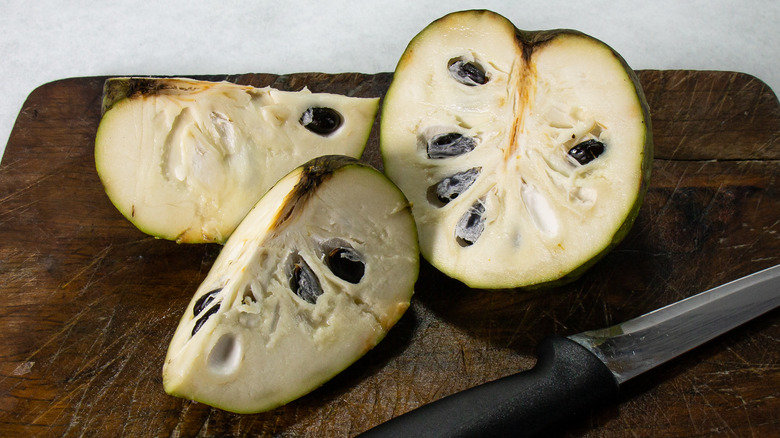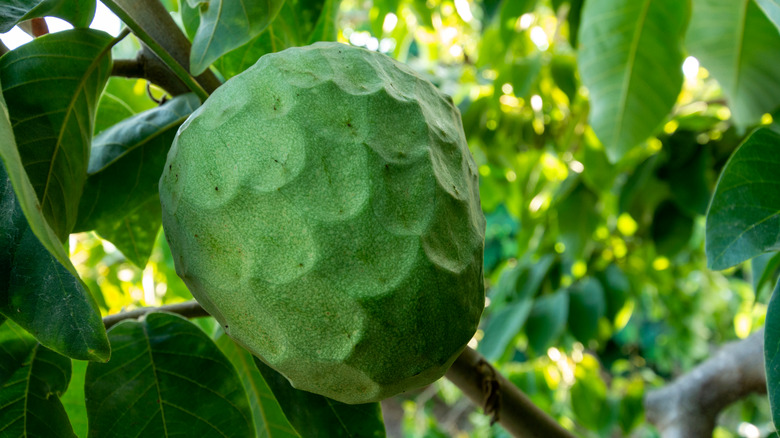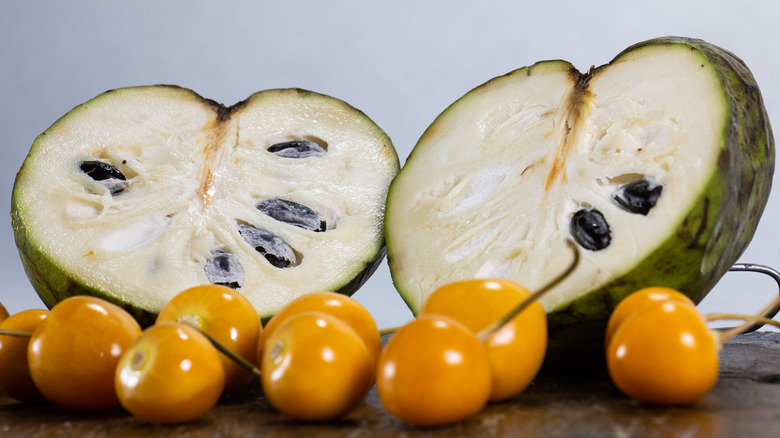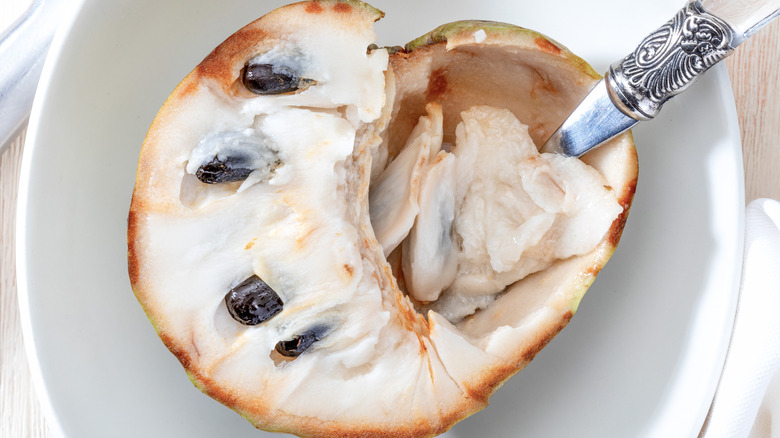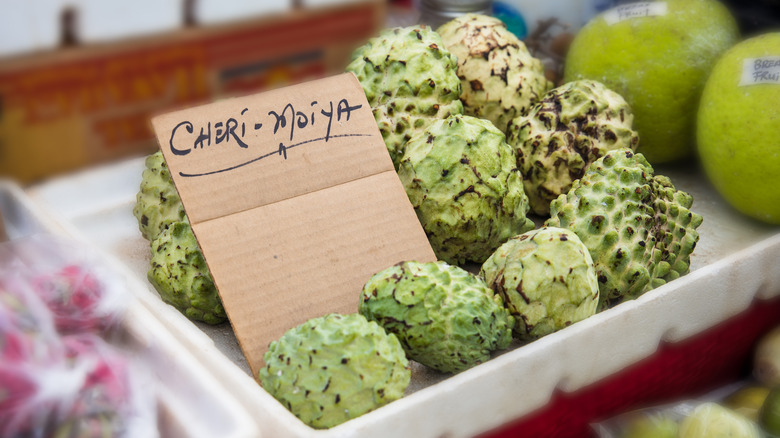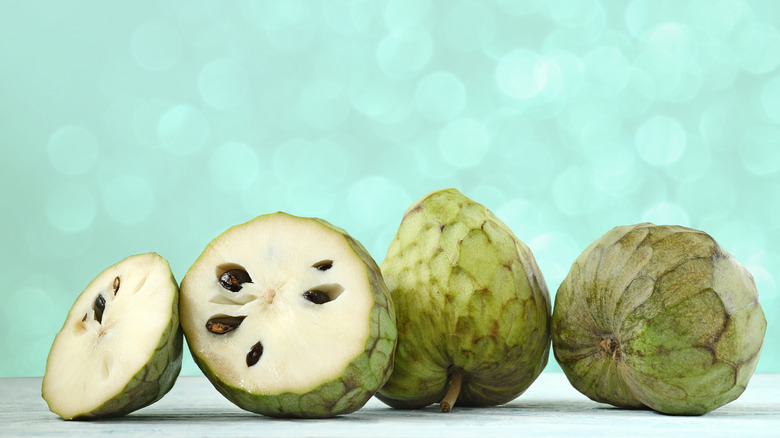What Is A Cherimoya And What Does It Taste Like?
The world of tropical fruits is wide, vast, and brimming with bold flavors and unique textures. Some fruits grow across the world and are regular finds in most supermarkets. Others are more likely to stay close to their source of origin, making the occasional appearance far from home. Climate, altitude needs, and natural patterns in agriculture can make some fruits more or less location-dependent (via JRank Science & Philosophy). Meanwhile, enthusiastic farmers might try to grow less common fruits to showcase something new to a region.
Cherimoyas, or Annona cherimola, are distinctly one of a kind 一 they aren't incredibly common, yet chances are the moment you catch sight of one you'll be filled with curiosity and want to give it a try, per Foodprint. The cherimoya's oddly textured exterior hides a sweet, silky pulp on the inside that you'll definitely want to taste. Although it might look like a fruit made to stand out alone, cherimoyas make a great match with other ingredients and can be used for a variety of culinary purposes.
What is a cherimoya?
Cherimoyas are primarily grown in South and Central America 一 especially in the valleys of Ecuador, Peru, and Colombia where they originate, according to FoodPrint. The fruit made its way to the Andes since it can thrive at higher altitudes in tropical climates (via Healthline). The plant then came to the United States in the 18th and 19th centuries, first arriving in Hawaii, and later, California and Florida. Nowadays, commercial production is centered in California, although the yield remains low since cherimoyas have very finicky growing conditions.
You may have come across other members of the Annonaceae family, including custard apples, sugar apples, and soursop (via Britannica). Although the sweet white flesh is similar, the fruits are distinct, per Nutrition and You. Apart from some physical differences, related fruits like custard apples are more likely to be found in South Asia.
Unlike some of its family members, cherimoyas have a smoother exterior with textured petal-like indents in the thin skin. The fruit ranges from darker green to a yellowish-green, before becoming brown when it is overripe. Cherimoyas are heart-shaped and can be as small as a tennis ball or grow to the size of footballs (via Fine Cooking). The big surprise comes when you cut into the fruit and taste the sweet, velvety white flesh. You'll have to avoid the numerous black seeds scattered throughout but the tasty pulp is definitely worth it.
What does cherimoya taste like?
Mark Twain described the cherimoya as, "the most delicious fruit known to man," and the piece of produce has rightfully earned this reputation (via National Geographic). Indeed, the flavor of this fruit is delightfully tropical and refreshing with a delicate balance. Cherimoyas taste like a combination of other regional fruits, including bananas, papayas, mangoes, and pineapples. The pulp is incredibly sweet with a hint of acidity that keeps it from being sickly. According to the Farmer's Almanac, some people even notice a taste of bubblegum in the fruit.
Aside from the fresh burst of flavor, cherimoyas have a unique texture that makes them pleasant to eat. Once the fruit has sufficiently ripened, the flesh becomes smooth and creamy. Cherimoyas are part of the custard apple family, aptly named for their silky flan-like consistency which can be conveniently eaten with a spoon (via Food Print). To maximize the flavor and textural sensations, try chilling your cherimoya prior to eating it.
How to cook with cherimoya
First, you'll need to remove the skin before digging into your cherimoya, since it contains toxic seeds and skin, per Cooking On the Weekends. Either peel it entirely or slice the fruit in half and scoop the flesh out with a spoon. Be careful navigating the black seeds, as their contents are also toxic. It's all worth it though once you savor the silky pulp inside. Cherimoyas are certainly easy to enjoy alone but Healthline suggests trying them in a fruit salad, yogurt, oatmeal, or smoothie. For a unique idea, blend them into a salad dressing to incorporate a touch of sweetness. To contrast the sweet flavors, Food Print recommends squeezing some lime juice over the white pulp. While you're at it, add some cherimoya in your next cocktail creation.
Although cherimoyas are delicious when eaten fresh, their sweet flavor complements cooked desserts. Just scoop out the flesh and spread it onto a pie crust to make a tart. For a tropical refresher, Fine Cooking recommends making sorbet or ice cream with cherimoyas. If you're up for the challenge, the source suggests incorporating it into a soufflé or meringue.
Where to buy cherimoyas
You might not be able to find cherimoyas in most supermarkets on a regular basis, but if you're lucky, they might make a seasonal appearance in the produce aisle. Los Angeles Times indicates that cherimoyas are generally in season from November to late spring. If you live in California, you may be able to find cherimoyas at your local farmer's market during the peak of their season.
The skin can be very fragile once the fruit ripens so it's best to buy firm green cherimoyas without cracks or blemishes. Fine Cooking recommends letting the fruit ripen on your counter and refrigerating it for up to three days once it starts to soften 一 aim for the texture of a perfect avocado. To enjoy it in its prime, don't wait too long before eating a ripe cherimoya, or you may end up missing out on the experience.
Nutritional information about cherimoyas
As a tropical fruit, a cherimoya has plenty of benefits to enjoy in every sweet bite. Healthline reports that the fruit is high in fiber, with 5 grams per cup. A high fiber diet can assist with smooth digestion, reducing inflammation in the body, making this fruit a welcome addition to any meal. A cup of cherimoya also contains 5 grams of protein according to the Farmer's Almanac. Apart from their impressive nutrient profile, cherimoyas are also high in a number of vitamins and minerals, in particular vitamin B6, C, potassium, and magnesium. These nutrients provide sources of antioxidants and support a healthy immune system.
Amidst all of its nutritious qualities, the fruit's peel and seeds contain a compound called annonacin that is toxic in large amounts. The poison targets the brain and nervous system, so take caution when preparing the fruit. All in all, you can't go wrong with this supremely delicious piece of produce that can make anyone excited to indulge in some extra fruit.
